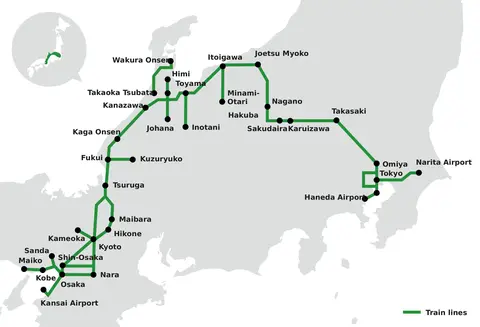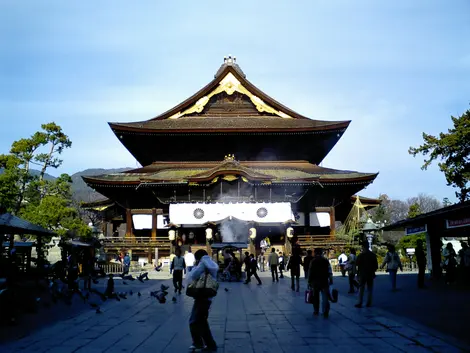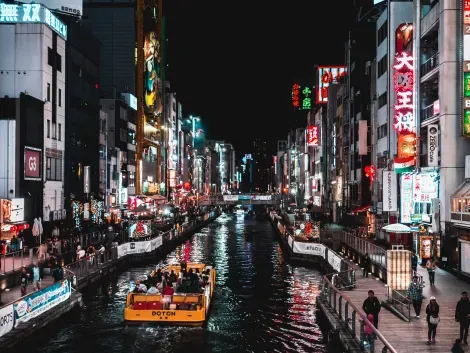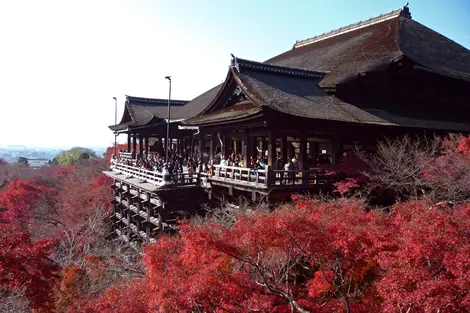Osaka-Tokyo Hokuriku Arch Pass

A Regiao De Hokoriku
Aninhada entre o mar e as montanhas, no coração do Japão, a região de Hokuriku é um magnífico tesouro cultural histórico. Explore os Alpes japoneses, os banhos termais de Takasaki e os locais de ski de Nagano.
Logo, siga em direção a Kanazawa, um centro arte contemporânea e de artesãos conhecida pelo seu famoso jardim Kenroku-en, um dos três mais belos do Japão.
Em Fukui, mergulhe na história do Japão explorando os múltiplos lugares culturais da cidade. Deixe-se seduzir pelos templos e cervos sagrados de Nara, pelas ruas tradicionais e a atmosfera incomparável de Quioto, pelas luzes de neon e a gastronomia audaciosa de Osaka.

Highlights of the OSAKA-TOKYO HOKURIKU ARCH PASS:
How to use the Osaka-Tokyo Hokuriku Arch Pass?
Delivery
We will send a paper voucher to your home address; please order allowing sufficient time for delivery. (The paper voucher is not the ticket itself; you cannot use it without exchanging in Japan)
Exchange
The voucher must be exchanged for the pass within 90 days of the voucher issue date.
You can redeem your voucher for a physical pass at one these locations:
Seat Reservations
- You cannot make a seat reservation without having exchanged the voucher first.
- This pass does not allow for reservations on the Haruka Airport Express between Kyoto and the Kansai International Airport in Osaka.
- With this pass, no additional fee is required when reserving seats. Non-reserved Ordinary Class cars can be accessed freely.
- In order to travel in first class (Green Car or Gran Class), or on night cars, an extra fee is required.
- To access the platforms, show your pass to the staff manning the gate to the platform.
- To reserve a seat, show your pass to the staff at the ticket office.
- It is a personal pass and cannot be transferred.
- Please always carry your passport when using the pass, as station and train staff may check it.
Validity
The following trains are accessible with the Osaka-Tokyo Hokuriku Arch Pass:
Cancellation terms
An unused voucher is refundable for one year from the date of issue.
The voucher can only be refunded if it has never been exchanged in Japan.
A cancellation fee of 15% of the value of the voucher will be retained.
No refund is possible for a voucher received by us more than one year from the date of issue.
No refund is possible for a lost or stolen pass.
Eligibility
Visitors traveling as tourists who have a temporary visitor entry status are eligible for this pass. Japanese passport holders are not eligible for this pass. You will need to present your passport at the time of exchange.
From the cities to the mountains to the sea
With the Osaka-Tokyo Hokuriku Arch Pass travelers can travel between the two Japanese megacities of Tokyo and Osaka, making stops along the way and exploring the Japanese Alps and Hokuriku, at destinations such as Karuizawa, Nagano, Toyama, and Kanazawa.
Nagano and the Japanese Alps
From Tokyo, the prefecture of Nagano is a relatively short trip away via the Hokuriku Shinkansen. This is one of the largest prefectures in all of Japan and is one of the very few that are fully landlocked. It's geographic location amongst the Japanese Alp mountain range means it has a relatively high elevation, with milder summers than other places on the archipelago, as well as lush landscapes blessed with nature.
Karuizawa is a favorite day trip for the people of Tokyo, great for its art scene, food scene, and golden foliage during autumn. Up further into the prefecture is the capital of Nagano City, host to the 1998 Winter Olympics and some of the most storied historic shrines and temples in Japan, including Zenko-ji Temple, which the city was initially built around centuries ago. A bit away from the city center, Jigokudani Monkey Park is home to a troupe of Japanese Macaques, known for their distinct behavior when bathing in natural hot springs during winter.
The Hokuriku Region
The prefectures of Hokuriku take great pride in the blessings of the Japan Sea. On one side, commanding waters provide a bounty of world-renowned seafood and other resources. On the other, the mountains of the Japanese Alps tower over the land, their peaks grazing the sky above and hosting an ecosystem worlds apart from the depth of the sea. Within the towns and cities of the prefectures, a thriving arts and crafts culture is revered, steeped both in tradition and free expression using mediums such as glass and pottery.
Niigata, Toyama, Ishikawa, and Fukui Prefectures are often grouped together to define this region, each with a distinct culinary culture derived from what they source from the Japan Sea Waters. Buri (Amberjack), shiroebi (glass shrimp), nodoguro (blackthroat sea perch), and snow crab are staples of the area, proudly served in local restaurants while also being crown jewels of menus at fine establishments throughout the world.
For nature-lovers, two of Japan's holy mountains call Hokuriku home: Tateyama in Toyama and Hakusan in Ishikawa. The two are holy symbols of the region, often serving as defining landmarks since ancient Japan, and climbing them is often seen as a rite of passage for many.
The Kansai Region
Ask any traveler to Japan to name a region in the country, and the answer will likely be Kansai. The Kansai Region is a diverse and eclectic collection of prefectures, cities, and towns that embody Japanese culture like no other.
From Tsuruga, Fukui in the Hokuriku Region, the Thunderbird Limited Express Train will take people out to Osaka, the largest city in Kansai and third-largest in all of Japan via population. This is an urban metropolis combining both an energetic city environment as well as long-standing history with attractions like Osaka Castle and the Mozu-Kofun Tombs.
Kyoto is the most distinctly history-defined city in Kansai, however, with its collection of 17 different temples, shrines, and other landmarks being considered UNESCO World Heritage Sites. Then, Hyogo Prefecture has much to offer, from the famous Kinosaki-Onsen hot spring town to the elegant air of Kobe, where the luxurious wagyu known as Kobe Beef must be tried.
Preguntas frecuentes

















